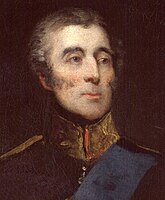Wellington–Peel ministry
From Wikipedia, the free encyclopedia
The Conservative government of the United Kingdom of Great Britain and Ireland that began in 1828 and ended in 1830 was led by Arthur Wellesley, 1st Duke of Wellington in the House of Lords and Robert Peel in the House of Commons.
Wellington–Peel ministry | |
|---|---|
 | |
| 1828–1830 | |
  | |
| Date formed | 22 January 1828 |
| Date dissolved | 16 November 1830 |
| People and organisations | |
| Monarch |
|
| Prime Minister | Duke of Wellington |
| Home Secretary | Sir Robert Peel |
| Total no. of members | 92 appointments |
| Member party | Tories |
| Status in legislature | |
| Opposition party | Whigs |
| Opposition leaders |
|
| History | |
| Outgoing election | 1830 general election |
| Legislature terms | |
| Predecessor | Goderich ministry |
| Successor | Grey ministry |
History
Formation
The Duke of Wellington finally came to power after the abortive attempt at a Canningite-Whig coalition government came to an end with Viscount Goderich's resignation in January 1828. The government included several men from the previous administration, but four of the most important, Lords Dudley and Palmerston and Messrs Huskisson and Grant, resigned in May 1828.
Fate
The Duke oversaw the introduction of Catholic Emancipation, but remained resolutely opposed to parliamentary reform, and as a result lost a vote of no confidence on 15 November 1830. The Whigs under Lord Grey then formed the government which was to pass the Great Reform Act.
Cabinet

,


January 1828 – November 1830
Full list of ministers
Summarize
Perspective
Members of the Cabinet are indicated by bold face.
- Notes
References
- Tout, T. F. (1910). An advanced history of Great Britain from the earliest times to the death of Edward VII. New York: Longmans, Green. pp. 740–741. OL 13991885M.
- Chris Cook and John Stevenson, British Historical Facts 1760–1830
- Joseph Haydn and Horace Ockerby, The Book of Dignities
Wikiwand - on
Seamless Wikipedia browsing. On steroids.
